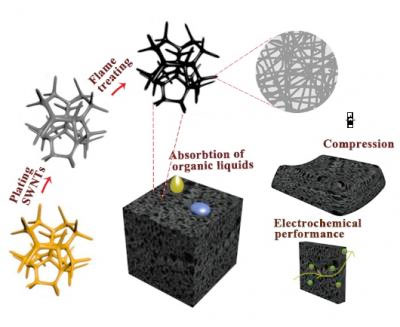| Aug 23, 2018 | |
Large scale preparation method of high quality SWNT sponges(Nanowerk News) In a paper published in NANO ("Superfast Preparation of SWNT Sponge by Flame Burning Method and Its Adsorptive, Elastic and Electrochemical Properties"), a group of researchers have developed a simple flame burning method to prepare single-walled carbon nanotube (SWNT) sponges on a large scale. The SWNT sponge has multifunctional properties and can be used in the fields of cleaning-up, sensing and energy storage. |
|
| How to prepare the lightweight and porous carbon nanotube (CNT) sponges with mass production and without high energy and time consumption? | |
 |
|
| The 3D carbon nanotube sponge prepared by superfast flame burning method. (Image: Shihong Yue) | |
| The researchers have discovered a method of preparing single-walled carbon nanotube (SWNT) sponges with a 3D elastic interconnected hollow skeleton network by burning the commercial polyurethane (PU) sponges coated with SWNTs. | |
| The PU sponge can be removed in an ethanol flame in less than 20 s, leaving sponge-like structures. Compared with previously reported chemical vapor deposition (CVD), freeze-drying method, the flame burning method used in this work has the advantages of being density controlled, low cost and suitable for large-scale production. | |
| Additionally, the advantage of sponge shape and size controlled by pretreatment of PU templates is also the most important aspect of the method, superior to other methods. | |
| The most significant aspect of this study is that the SWNT sponges was developed by a superfast flame burning method in less than 20 s through removing PU sponge template coated with SWNTs in an ethanol flame, which has not ever been reported. | |
| The as-synthesized SWNT sponges exhibit a series of comparable properties, including high conductivity, moderate organic liquid adsorption, good elasticity and high specific capacitance. Also, the sponges could reach an ultralow density of 0.8 mg cm-3 and keep the original geometry of PU template without distortion. | |
| The high hydrophobicity endows the SWNT sponges with admirable adsorption rate and capacity for organic solvents. The sponges could not only reach a maximum compressive stress of 11,500 Pa at 80% strain, but also bear more than 1000 compression cycles at 60% strain. | |
| Further, the porous SWNT sponges used as a flexible electrode material achieves a high specific capacitance of 126.8 F g-1 and 95% capacitive retention over 10,000 cycles. |
| Source: World Scientific | |
|
Subscribe to a free copy of one of our daily Nanowerk Newsletter Email Digests with a compilation of all of the day's news. |
